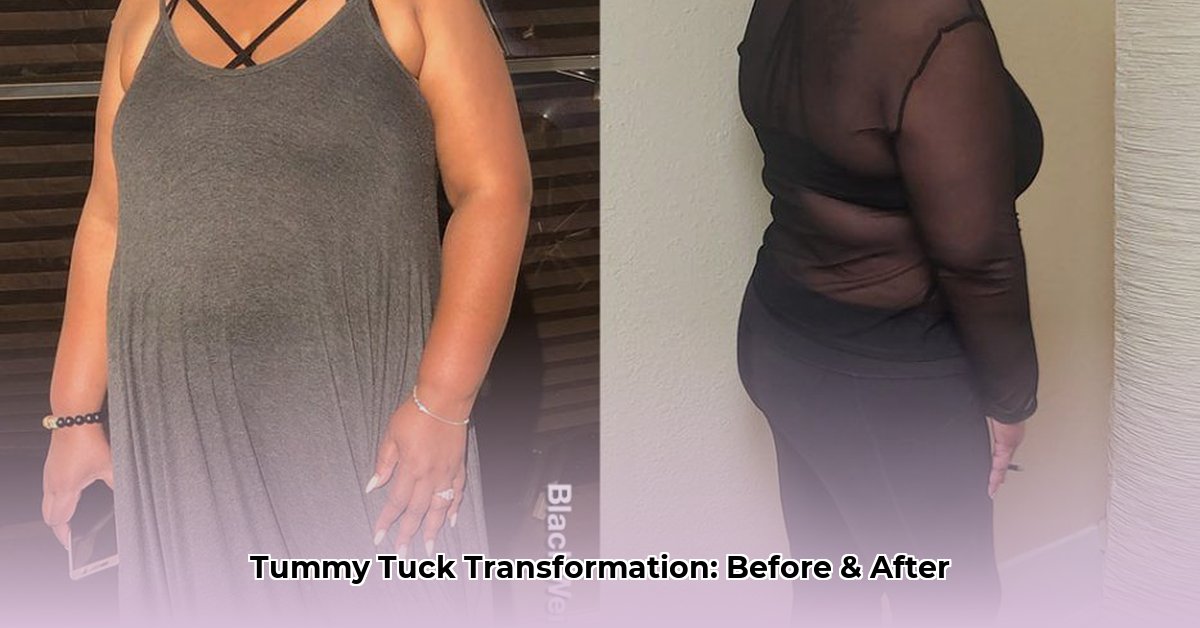
Imagine reaching your weight loss goal, feeling healthier than ever, yet still seeing loose, sagging skin where your once-larger belly used to be. This is a common experience after significant weight loss, leaving many feeling frustrated and self-conscious. A weight loss tummy tuck (abdominoplasty) might be the solution you've been searching for. This article explores this procedure, guiding you through what to expect, who is a good candidate, and the steps involved. We'll also showcase real before-and-after photos—with patient consent—illustrating the transformative results this surgery can achieve.
Understanding the Weight Loss Tummy Tuck Procedure
A tummy tuck is a surgical procedure designed to remove excess skin and fat from the abdomen, simultaneously tightening the underlying abdominal muscles. This isn't merely about aesthetics; it's about restoring comfort and improving body image after significant weight loss. The weakened abdominal muscles, often a consequence of weight fluctuations, are strengthened, resulting in a flatter, firmer stomach. The procedure's effectiveness is dramatically shown in before-and-after photos.
Types of Tummy Tucks
Several types of tummy tucks cater to individual needs. These include:
- Standard Tummy Tuck: Addresses excess skin and fat in the lower abdomen.
- Extended Tummy Tuck: Also addresses excess skin and fat on the flanks (sides).
- Full Abdominoplasty: A more extensive procedure addressing the entire abdomen and often requiring more extensive muscle repair.
The choice of procedure depends on the extent of excess skin, the amount of muscle laxity, and your personal goals. A consultation with a qualified surgeon is crucial for determining the best option for you.
Am I a Good Candidate for a Weight Loss Tummy Tuck?
Several factors determine your suitability for a weight loss tummy tuck. Ideal candidates generally meet these criteria:
- Weight Stability: You should have reached a stable weight and maintained it for at least six months to a year. Significant future weight fluctuations could negatively impact the results.
- Realistic Expectations: A tummy tuck is not a magic bullet. Understand that while it significantly improves your appearance, it won’t eliminate all stretch marks or cellulite.
- Good Overall Health: Pre-existing medical conditions, current medications, and smoking habits will be assessed by your surgeon.
Weight Loss Tummy Tuck Before & After: Real Patient Transformations
(Insert high-quality before-and-after photos with patient consent. For each photo, include a brief, compelling narrative explaining the patient’s journey, their experience, and the outcome of the procedure. Emphasize the positive impact on their body image and overall well-being. Be mindful of patient privacy and ensure all photos are ethically sourced and presented.)
Example: “After losing 100 pounds, I was left with loose, hanging skin that made me self-conscious. The tummy tuck not only removed the excess skin but also tightened my abdominal muscles, giving me the flatter stomach I'd always wanted. I feel so much more confident and comfortable in my own skin now.” (Include before & after image)
*(Repeat with additional patient stories and images, emphasizing individual experiences and positive outcomes). *
The Tummy Tuck Procedure: A Simplified Overview
The procedure typically involves:
- Anesthesia: General anesthesia is administered to ensure your comfort and painlessness.
- Incision: A strategically placed incision is made, often low across the lower abdomen for minimal visibility.
- Muscle Repair: Weakened abdominal muscles are tightened and reshaped, enhancing abdominal contour.
- Excess Tissue Removal: Excess skin and fat are carefully removed, resulting in a more sculpted abdomen.
- Closure: The incision is closed with sutures and a drain may be temporarily placed to remove excess fluid.
The exact steps and techniques may vary depending on the type of tummy tuck performed.
Recovery and Potential Risks: Addressing Concerns
Recovery takes several weeks, including some discomfort, swelling, and bruising. Pain medication is often prescribed. A compression garment is commonly worn to support healing and minimize swelling. While rare, potential complications can include infection, seroma (fluid buildup), and excessive scarring. Your surgeon will discuss these possibilities and provide guidance on managing any risks.
Cost and Insurance Coverage: A Financial Perspective
The cost of a weight loss tummy tuck is variable, depending on the type of procedure, surgeon's fees, anesthesia costs, and facility fees. Since it is often considered a cosmetic procedure, insurance coverage is typically not provided. It is essential to discuss the total cost and payment plans with your surgeon beforehand.
Choosing Your Surgeon: A Crucial Step
Selecting a qualified and experienced surgeon is paramount. Seek a board-certified plastic surgeon with a proven track record of successful weight loss tummy tucks. Read reviews, examine before-and-after photos, and schedule consultations to discuss your goals and ask questions about their approach.
Conclusion: Embracing a New Chapter
A weight loss tummy tuck can be life-changing for suitable candidates. It addresses the physical and emotional challenges associated with excess abdominal skin after weight loss. The procedure can dramatically boost self-confidence and improve overall well-being. Remember realistic expectations and thorough research are essential for achieving positive and lasting results. Consult a qualified surgeon to determine your suitability and embark on this transformative journey. Begin your research today by scheduling a consultation!